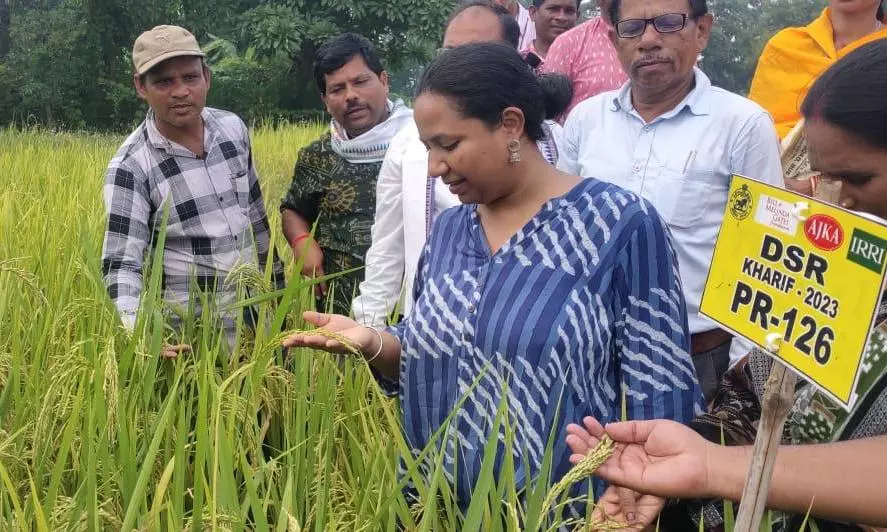
How rice researcher Swati Nayak bridges the gap between lab and field
The IRRI scientist, who bagged this year’s Norman E Borlaug Award for Field Research and Application, speaks with The Federal

Smallholder rice farmers, particularly in eastern India, are not usually aware of new and improved high-yielding varieties that are in demand, and even when they have the knowledge, do not grow them because quality seed is not available just before the sowing season.
This remains a challenge even 60 years after the Green Revolution, Swati Nayak, winner of this year’s Norman E Borlaug Award for Field Research and Application, said in a Zoom interview to The Federal. Nayak heads the International Rice Research Institute’s (IRRI) global research programme for South Asia on seed system and product management. She is the third Indian to receive the award since 2012, when it was instituted with an endowment from the Rockefeller Foundation.
The foundation was crucial for India’s Green Revolution. It funded Borlaug’s research in dwarf wheat varieties and helped set up IRRI in Manila, along with the Ford Foundation. Borlaug is known as the Father of the Green Revolution in wheat. He provided India with semi-dwarf varieties that revolutionised wheat production in the mid-1960s. It is through IRRI that India got the first high-yielding semi-dwarf variety of Rice (IR8) and other versions which led to the Green Revolution in rice.
The award is given to those below 40 years of age by the World Food Prize Foundation, which Borlaug set up. Parenthetically, agricultural scientist MS Swaminathan,who passed away on September 28, got the first World Food Prize.
Public versus private sectors
The private sector is very good at making quality seed of newer varieties available to farmers because of competition and the profit motive. For instance, Mahyco Monsanto Biotech, now taken over by Bayer, had licensed 49 franchisees to put its proprietary bollworm killing Bt trait in their cotton hybrids. So, there was never a shortage of the genetically-modified cottonseed, though hybrid cottonseed production is labour-intensive.
But Nayak says the private sector focuses on high-value crops like vegetables or maize, rice and bajra hybrids. It avoids open-pollinated broadacre crops like wheat and rice because the grain can be saved and sown as seed (unlike hybrids where seed must be bought every year).
The public sector, Nayak says, has done a good job of breeding high-yielding varieties of rice suitable for various agro-ecologies. According to her, about 1,500 varieties have been released so far, but only about 400 get indented for seed production, of which about 50 are in high demand. There is a system of seed testing before they are released by variety release committees at the centre and the states, but farmers do not obtain the yields claimed by breeders, who grow them under expert supervision and with machines and devices that smallholder farmers cannot afford.
Nayak’s mandate
Nayak says her mandate is to bridge the gap between the lab and the field and make quality seed available to those outside the formal seed system. It begins with writing to the breeders (agricultural universities or research institutes) to send their new varieties for adaptation testing in farmers’ fields. Nayak’s team at IRRI segments the nominations as per (a) establishment method (transplanting or direct seeding), (b) maturity group (early or later maturing), (c) grain type (say, medium slender), and (d) ecology (irrigated, rainfed upland or rainfed lowlands). The testing is done under actual user conditions. Even the cultivation practices are those that farmers usually adopt.
Leveraging the network of Krishi Vigyan Kendras (KVKs, of which there are 730) and farmers’ collectives like producer companies, farmers are made aware of the new varieties and guided in cultivation practices. The extension workers are given extensive training in person, or with digital technology (short video clips on WhatsApp).
Since more than half of the smallholder rice farmers in the eastern region are outside the formal seed supply system, according to Nayak, her team tries to get quality seed produced locally, though self-help groups or farmers’ collectives. Nayak says the women’s groups she works with in India and Bangladesh have in the last two years produced a little over eight tonnes of quality seed, which can cover 170 hectares.
Nayak is known for persuading the farmers of Odisha’s Mayurbhanj district, when she began there in 2013, to adopt Sahbhagi Dhan, a drought-tolerant rice variety of the National Rice Research Institute (NRRI), Cuttack, released in 2008. It became very popular even beyond the district. Nayak says her emphasis is replacing older varieties with those that are less than five years old, and to get farmers to use certified seed more often than saved grain.

